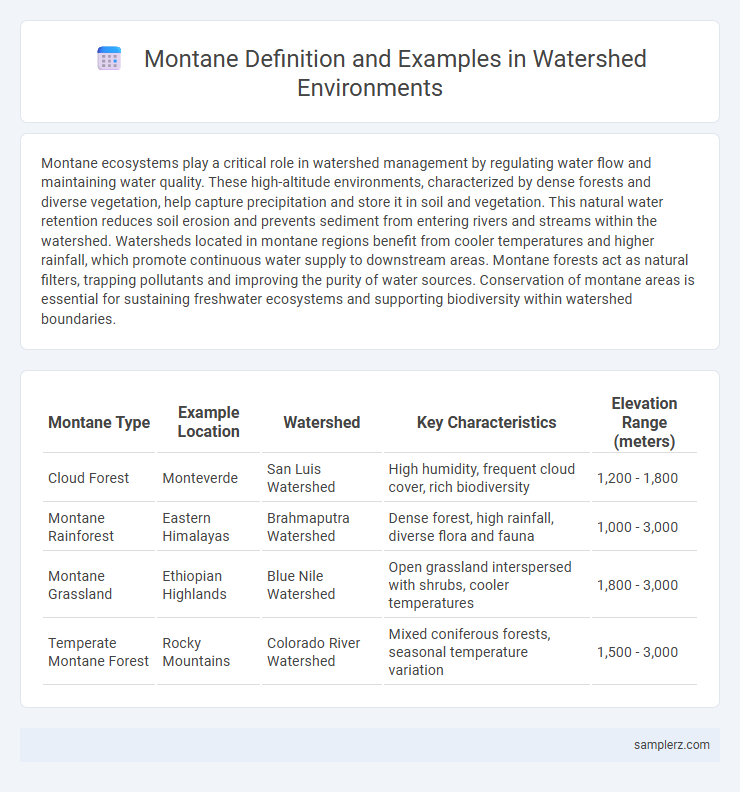Montane ecosystems play a critical role in watershed management by regulating water flow and maintaining water quality. These high-altitude environments, characterized by dense forests and diverse vegetation, help capture precipitation and store it in soil and vegetation. This natural water retention reduces soil erosion and prevents sediment from entering rivers and streams within the watershed. Watersheds located in montane regions benefit from cooler temperatures and higher rainfall, which promote continuous water supply to downstream areas. Montane forests act as natural filters, trapping pollutants and improving the purity of water sources. Conservation of montane areas is essential for sustaining freshwater ecosystems and supporting biodiversity within watershed boundaries.
Table of Comparison
| Montane Type | Example Location | Watershed | Key Characteristics | Elevation Range (meters) |
|---|---|---|---|---|
| Cloud Forest | Monteverde | San Luis Watershed | High humidity, frequent cloud cover, rich biodiversity | 1,200 - 1,800 |
| Montane Rainforest | Eastern Himalayas | Brahmaputra Watershed | Dense forest, high rainfall, diverse flora and fauna | 1,000 - 3,000 |
| Montane Grassland | Ethiopian Highlands | Blue Nile Watershed | Open grassland interspersed with shrubs, cooler temperatures | 1,800 - 3,000 |
| Temperate Montane Forest | Rocky Mountains | Colorado River Watershed | Mixed coniferous forests, seasonal temperature variation | 1,500 - 3,000 |
Introduction to Montane Ecosystems in Watersheds
Montane ecosystems in watersheds are characterized by their elevation-specific vegetation and climate, which play a critical role in regulating water flow and quality. These ecosystems support diverse plant and animal species, while their forested slopes enhance soil stability, reducing erosion and sedimentation in downstream water bodies. The unique hydrological functions of montane zones contribute significantly to watershed health and resilience.
Key Characteristics of Montane Watersheds
Montane watersheds are characterized by steep gradients, dense coniferous forests, and well-defined stream networks that facilitate efficient water runoff and sediment transport. These ecosystems play a crucial role in maintaining water quality by filtering pollutants and regulating flow during snowmelt and rainfall events. High biodiversity and significant elevation changes contribute to varied microclimates within montane watersheds, supporting diverse aquatic and terrestrial species.
Role of Montane Forests in Watershed Hydrology
Montane forests play a critical role in watershed hydrology by regulating streamflow and maintaining water quality through soil stabilization and filtration of pollutants. These forests enhance groundwater recharge by promoting infiltration and reducing surface runoff, which prevents erosion and sedimentation in downstream water bodies. Studies in the Andes and Himalayas confirm montane ecosystems contribute significantly to seasonal water availability for millions of people.
Notable Examples of Montane Watersheds Worldwide
The Andes Mountains host one of the most notable montane watersheds, where high-altitude ecosystems regulate water flow and sustain biodiversity across South America. The Himalayas support critical montane watersheds that feed major river systems like the Ganges and Brahmaputra, ensuring water availability for millions downstream. In North America, the Sierra Nevada range forms a vital montane watershed that supplies freshwater to California's agricultural and urban areas.
Biodiversity in Montane Watershed Regions
Montane watershed regions host unique biodiversity due to their varied elevation gradients and microclimates, supporting a wide range of endemic flora and fauna. These areas serve as critical habitats for species such as the cloud forest amphibians and montane birds, which rely on the cool, moist environments. Conservation of montane watersheds is essential for maintaining water quality and ecosystem services that sustain both wildlife and human communities downstream.
Ecosystem Services Provided by Montane Watersheds
Montane watersheds play a crucial role in regulating water flow, maintaining water quality, and supporting biodiversity through their dense vegetation and soil structure. These ecosystems provide essential services such as carbon sequestration, erosion control, and habitat for endemic species, which contribute to overall watershed stability. By sustaining these functions, montane watersheds ensure clean water supply for downstream communities and support climate resilience in mountainous regions.
Human Impact on Montane Watershed Ecosystems
Human activities such as deforestation, agriculture, and urbanization significantly disrupt montane watershed ecosystems by increasing soil erosion, reducing water quality, and altering natural hydrological cycles. These impacts accelerate sedimentation in streams and rivers, decrease biodiversity, and compromise the watershed's ability to regulate water flow and nutrient cycling. Sustainable land management practices are critical to mitigating human-induced damage and preserving the ecological balance of montane watersheds.
Montane Soil and Water Relationships
Montane regions within watersheds play a critical role in regulating soil and water dynamics due to their unique elevation-driven climate and vegetation patterns. Montane soils often exhibit high organic content and enhanced water retention capacity, which supports sustained groundwater recharge and minimizes surface runoff. These soil-water interactions in montane zones influence watershed hydrology by stabilizing stream flows and reducing erosion, thereby maintaining ecosystem health downstream.
Conservation Strategies for Montane Watersheds
Montane watersheds, characterized by elevated terrain and unique biodiversity, require targeted conservation strategies such as reforestation, sustainable land use, and erosion control to maintain water quality and ecosystem resilience. Implementing buffer zones and restoring native vegetation helps protect soil stability and regulate hydrological cycles critical for downstream communities. These measures enhance habitat connectivity and mitigate the impact of climate change on montane watershed ecosystems.
Future Challenges Facing Montane Watershed Environments
Montane watershed environments face future challenges including increased risks of erosion and sedimentation due to intensified rainfall patterns and deforestation. Climate change exacerbates the vulnerability of these watersheds by altering hydrological cycles, leading to unpredictable water availability and degraded water quality. Sustainable management strategies must address these threats to preserve biodiversity and maintain ecosystem services critical for downstream communities.

example of montane in watershed Infographic
 samplerz.com
samplerz.com